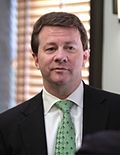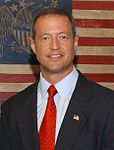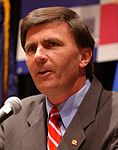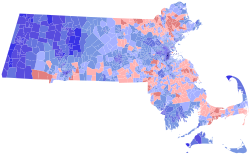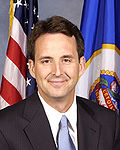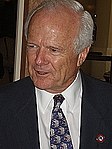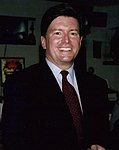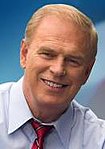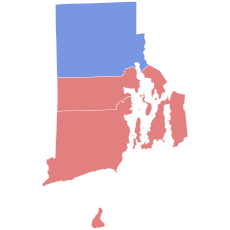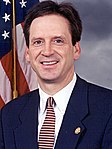United States gubernatorial elections were held on November 7, 2006, in 36 states and two territories. The elections coincided with the midterm elections of the United States Senate and the United States House of Representatives.
| |||||||||||||||||||||||||
38 governorships 36 states; 2 territories | |||||||||||||||||||||||||
|---|---|---|---|---|---|---|---|---|---|---|---|---|---|---|---|---|---|---|---|---|---|---|---|---|---|
| |||||||||||||||||||||||||
 Map of the results Republican hold Democratic hold Democratic gain No election | |||||||||||||||||||||||||
Democrats won open Republican-held governorships in Arkansas, Colorado, Massachusetts, New York, and Ohio; and they defeated Republican incumbent Bob Ehrlich in Maryland while retaining all of their seats, including their lone open seat in Iowa. Meanwhile, Republicans held open seats in Florida, Idaho, and Nevada, as well as Alaska, where incumbent governor Frank Murkowski was defeated in the primary. Voters in the United States territories of Guam (then-Republican) and the United States Virgin Islands (then-Democratic, but term-limited) also chose their governors and voters elected a new mayor for the District of Columbia, the District's chief executive.
As part of the 2006 Democratic sweep, Democrats did not lose a single incumbent or open seat to the Republicans in any congressional or gubernatorial contest. The results of the 2006 elections gave Republicans 22 governors to the Democrats' 28, a reversal of the numbers held by the respective parties prior to the elections. Republicans held the majority of governorships from 1995 until 2007.
As of 2024, this election marked the last time that the Democratic Party won gubernatorial elections in Iowa, Ohio, Oklahoma, Tennessee, or Wyoming. This is also the very last gubernatorial election cycle in which the Republican Party won governorships in California, Connecticut, Hawaii, Minnesota, and Rhode Island to date.
Election ratings
| State | Incumbent | Last race | Sabato November 6, 2006[1] | Rothenberg November 2, 2006[2] | Cook November 6, 2006[3] | RCP November 6, 2006[4] | Result |
|---|---|---|---|---|---|---|---|
| Alabama | Bob Riley | 49.2% R | Likely R | Safe R | Safe R | Safe R | Riley (57.5%) |
| Alaska | Frank Murkowski | 55.9% R | Leans R | Leans R | Tossup | Leans R | Palin (48.3%) |
| Arizona | Janet Napolitano | 46.2% D | Safe D | Safe D | Safe D | Safe D | Napolitano (62.6%) |
| Arkansas | Mike Huckabee (Term-limited) | 53.0% R | Likely D (flip) | Likely D (flip) | Leans D (flip) | Leans D (flip) | Beebe (55.6%) |
| California | Arnold Schwarzenegger | 48.6% R | Likely R | Safe R | Leans R | Likely R | Schwarzenegger (55.9%) |
| Colorado | Bill Owens (Term-limited) | 62.6% R | Likely D (flip) | Likely D (flip) | Likely D (flip) | Likely D (flip) | Ritter (57.0%) |
| Connecticut | Jodi Rell | 56.1% R | Safe R | Safe R | Safe R | Safe R | Rell (63.2%) |
| Florida | Jeb Bush (Term-limited) | 56.0% R | Leans R | Likely R | Leans R | Leans R | Crist (52.2%) |
| Georgia | Sonny Perdue | 51.4% R | Likely R | Safe R | Leans R | Likely R | Perdue (58.0%) |
| Hawaii | Linda Lingle | 51.6% R | Safe R | Safe R | Safe R | Safe R | Lingle (62.5%) |
| Idaho | Jim Risch (Retired) | 56.3% R | Tossup | Leans R | Tossup | Tossup | Otter (52.7%) |
| Illinois | Rod Blagojevich | 52.2% D | Leans D | Likely D | Leans D | Leans D | Blagojevich (49.8%) |
| Iowa | Tom Vilsack (Retired) | 52.7% D | Leans D | Leans D | Tossup | Leans D | Culver (54.0%) |
| Kansas | Kathleen Sebelius | 52.9% D | Likely D | Safe D | Safe D | Likely D | Sebelius (57.9%) |
| Maine | John Baldacci | 47.1% D | Leans D | Likely D | Leans D | Leans D | Baldacci (38.1%) |
| Maryland | Bob Ehrlich | 51.5% R | Leans D (flip) | Leans D (flip) | Tossup | Tossup | O'Malley (52.7%) |
| Massachusetts | Mitt Romney (Retired) | 49.8% R | Likely D (flip) | Likely D (flip) | Leans D (flip) | Likely D (flip) | Patrick (55.6%) |
| Michigan | Jennifer Granholm | 51.4% D | Leans D | Likely D | Tossup | Leans D | Granholm (56.4%) |
| Minnesota | Tim Pawlenty | 44.4% R | Tossup | Tossup | Tossup | Tossup | Pawlenty (46.7%) |
| Nebraska | Dave Heineman | 68.7% R | Safe R | Safe R | Safe R | Safe R | Heineman (73.4%) |
| Nevada | Kenny Guinn (Term-limited) | 68.2% R | Leans R | Tossup | Tossup | Leans R | Gibbons (47.9%) |
| New Hampshire | John Lynch | 50.4% D | Safe D | Safe D | Safe D | Safe D | Lynch (74.0%) |
| New Mexico | Bill Richardson | 55.5% D | Safe D | Safe D | Safe D | Safe D | Richardson (68.8%) |
| New York | George Pataki (Retired) | 49.4% R | Safe D (flip) | Likely D (flip) | Safe D (flip) | Safe D (flip) | Spitzer (65.7%) |
| Ohio | Bob Taft (Term-limited) | 57.8% R | Likely D (flip) | Likely D (flip) | Safe D (flip) | Likely D (flip) | Strickland (60.5%) |
| Oklahoma | Brad Henry | 43.3% D | Safe D | Safe D | Safe D | Safe D | Henry (66.5%) |
| Oregon | Ted Kulongoski | 49.0% D | Tossup | Leans D | Tossup | Leans D | Kulongoski (50.7%) |
| Pennsylvania | Ed Rendell | 53.4% D | Safe D | Safe D | Safe D | Likely D | Rendell (60.3%) |
| Rhode Island | Donald Carcieri | 54.8% R | Leans R | Leans R | Tossup | Likely R | Carcieri (51.0%) |
| South Carolina | Mark Sanford | 52.9% R | Likely R | Safe R | Likely R | Safe R | Sanford (55.1%) |
| South Dakota | Mike Rounds | 56.8% R | Safe R | Safe R | Safe R | Safe R | Rounds (61.7%) |
| Tennessee | Phil Bredesen | 50.6% D | Safe D | Safe D | Safe D | Likely D | Bredesen (68.6%) |
| Texas | Rick Perry | 57.8% R | Safe R | Likely R | Likely R | Likely R | Perry (39.0%) |
| Vermont | Jim Douglas | 58.7% R | Safe R | Safe R | Likely R | Safe R | Douglas (56.3%) |
| Wisconsin | Jim Doyle | 45.1% D | Leans D | Tossup | Tossup | Leans D | Doyle (52.8%) |
| Wyoming | Dave Freudenthal | 50.0% D | Safe D | Safe D | Safe D | Safe D | Freudenthal (70.0%) |
Race summary
States
| State | Incumbent | Party | First elected | Result | Candidates |
|---|---|---|---|---|---|
| Alabama | Bob Riley | Republican | 2002 | Incumbent re-elected. |
|
| Alaska | Frank Murkowski | Republican | 2002 | Incumbent lost renomination. New governor elected. Republican hold. |
|
| Arizona | Janet Napolitano | Democratic | 2002 | Incumbent re-elected. |
|
| Arkansas | Mike Huckabee | Republican | 1996[a] | Incumbent term-limited. New governor elected. Democratic gain. |
|
| California | Arnold Schwarzenegger | Republican | 2003 (recall) | Incumbent re-elected. |
|
| Colorado | Bill Owens | Republican | 1998 | Incumbent term-limited. New governor elected. Democratic gain. |
|
| Connecticut | Jodi Rell | Republican | 2004[b] | Incumbent elected to full term. |
|
| Florida | Jeb Bush | Republican | 1998 | Incumbent term-limited. New governor elected. Republican hold. |
|
| Georgia | Sonny Perdue | Republican | 2002 | Incumbent re-elected. |
|
| Hawaii | Linda Lingle | Republican | 2002 | Incumbent re-elected. |
|
| Idaho | Jim Risch | Republican | 2006[c] | Incumbent retired. New governor elected. Republican hold. |
|
| Illinois | Rod Blagojevich | Democratic | 2002 | Incumbent re-elected. |
|
| Iowa | Tom Vilsack | Democratic | 1998 | Incumbent retired. New governor elected. Democratic hold. |
|
| Kansas | Kathleen Sebelius | Democratic | 2002 | Incumbent re-elected. |
|
| Maine | John Baldacci | Democratic | 2002 | Incumbent re-elected. |
|
| Maryland | Bob Ehrlich | Republican | 2002 | Incumbent lost re-election. New governor elected. Democratic gain. |
|
| Massachusetts | Mitt Romney | Republican | 2002 | Incumbent retired. New governor elected. Democratic gain. |
|
| Michigan | Jennifer Granholm | Democratic | 2002 | Incumbent re-elected. |
|
| Minnesota | Tim Pawlenty | Republican | 2002 | Incumbent re-elected. |
|
| Nebraska | Dave Heineman | Republican | 2005[d] | Incumbent elected to full term. |
|
| Nevada | Kenny Guinn | Republican | 1998 | Incumbent term-limited. New governor elected. Republican hold. |
|
| New Hampshire | John Lynch | Democratic | 2004 | Incumbent re-elected. |
|
| New Mexico | Bill Richardson | Democratic | 2002 | Incumbent re-elected. |
|
| New York | George Pataki | Republican | 1994 | Incumbent retired. New governor elected. Democratic gain. |
|
| Ohio | Bob Taft | Republican | 1998 | Incumbent term-limited. New governor elected. Democratic gain. |
|
| Oklahoma | Brad Henry | Democratic | 2002 | Incumbent re-elected. |
|
| Oregon | Ted Kulongoski | Democratic | 2002 | Incumbent re-elected. |
|
| Pennsylvania | Ed Rendell | Democratic | 2002 | Incumbent re-elected. |
|
| Rhode Island | Donald Carcieri | Republican | 2002 | Incumbent re-elected. |
|
| South Carolina | Mark Sanford | Republican | 2002 | Incumbent re-elected. |
|
| South Dakota | Mike Rounds | Republican | 2002 | Incumbent re-elected. |
|
| Tennessee | Phil Bredesen | Democratic | 2002 | Incumbent re-elected. |
|
| Texas | Rick Perry | Republican | 2000[e] | Incumbent re-elected. |
|
| Vermont | Jim Douglas | Republican | 2002 | Incumbent re-elected. |
|
| Wisconsin | Jim Doyle | Democratic | 2002 | Incumbent re-elected. |
|
| Wyoming | Dave Freudenthal | Democratic | 2002 | Incumbent re-elected. |
|
Territories and federal district
| Territory | Incumbent | Party | First elected | Result | Candidates |
|---|---|---|---|---|---|
| District of Columbia | Anthony A. Williams | Democratic | 1998 | Incumbent retired. New mayor elected. Democratic hold. |
|
| Guam | Felix Perez Camacho | Republican | 2002 | Incumbent re-elected. |
|
| U.S. Virgin Islands | Charles Wesley Turnbull | Democratic | 1998 | Incumbent term-limited. New governor elected. Democratic hold. |
|
Closest races
States where the margin of victory was under 5%:
- Minnesota, 1.0%
- Rhode Island, 2.0%
- Guam, 2.3%
- Nevada, 4.0%
States where the margin of victory was under 10%:
- Maryland, 6.5%
- Florida, 7.1%
- Alaska, 7.4%
- Wisconsin, 7.5%
- Maine, 7.7%
- Oregon, 8.1%
- Idaho, 8.6%
- Texas, 9.2%
- Iowa, 9.4%
Red denotes states won by Republicans. Blue denotes states won by Democrats.
Alabama
 | |||||||||||||||||
| |||||||||||||||||
| |||||||||||||||||
 County results Riley: 40–50% 50–60% 60–70% 70–80% Baxley: 40–50% 50–60% 60–70% 70–80% | |||||||||||||||||
| |||||||||||||||||
Incumbent Republican Bob Riley defeated Democratic Lieutenant Governor Lucy Baxley. Riley garnered 21% of African Americans' votes.
| Party | Candidate | Votes | % | |
|---|---|---|---|---|
| Republican | Bob Riley (incumbent) | 718,327 | 57.45 | |
| Democratic | Lucy Baxley | 519,827 | 41.57 | |
| Write-in | 12,247 | 0.98 | ||
| Total votes | 1,250,401 | 100.00 | ||
| Republican hold | ||||
Alaska
 | |||||||||||||||||||||||||
| |||||||||||||||||||||||||
| |||||||||||||||||||||||||
 Borough and census area results Palin: 40–50% 50–60% 60–70% Knowles: 40–50% 50–60% 60–70% 70–80% 80–90% | |||||||||||||||||||||||||
| |||||||||||||||||||||||||
Governor Frank Murkowski, suffering poor approval ratings, was not favored to win renomination. An August 8 poll by Rasmussen Reports showed that going into the primary election his approval rating was at 27%, while his disapproval rating stood at 72%. Former Wasilla Mayor Sarah Palin and former state Railroad Commissioner John Binkley challenged Murkowski in the Republican primary. Former governor Tony Knowles was widely considered the favorite to win the Democratic nomination. In the primary held on August 22, Palin won the Republican nomination for governor with 51.1% of the vote, Binkley received 29.6%, and Murkowski received just 18.9% of the vote.[6] Knowles won the Democratic nomination with 68.6% of the vote; state representative Eric Croft, who received 23.1% of the vote, was his nearest competitor.[6]
Palin campaigned on a clean government platform in a state with a history of corruption. An October 15 CRG Research poll had the candidates tied at 43%.[7] An October 28 Rasmussen Reports poll showed Palin leading Knowles by a single percentage point.[7]
Republican nominee Sarah Palin was elected with 48.3% of the vote, a plurality.
| Party | Candidate | Votes | % | |
|---|---|---|---|---|
| Republican | Sarah Palin | 114,697 | 48.33 | |
| Democratic | Tony Knowles | 97,238 | 40.97 | |
| Independent | Andrew Halcro | 22,443 | 9.46 | |
| Independence | Don Wright | 1,285 | 0.54 | |
| Libertarian | Billy Toien | 682 | 0.29 | |
| Green | David Massie | 593 | 0.25 | |
| Write-in | 384 | 0.16 | ||
| Total votes | 238,307 | 100.00 | ||
| Republican hold | ||||
Arizona
 | |||||||||||||||||
| |||||||||||||||||
| Turnout | 60.47%  4.14pp [8] 4.14pp [8] | ||||||||||||||||
|---|---|---|---|---|---|---|---|---|---|---|---|---|---|---|---|---|---|
| |||||||||||||||||
 County results Napolitano: 50–60% 60–70% 70–80% | |||||||||||||||||
| |||||||||||||||||
Incumbent Democratic Governor Janet Napolitano was re-elected in a landslide. Napolitano's widespread popularity contributed to her easy re-election; her general approval rating in October 2006, one month before the election, was at 58%.[9]
| Party | Candidate | Votes | % | |
|---|---|---|---|---|
| Democratic | Janet Napolitano (incumbent) | 959,830 | 62.58 | |
| Republican | Len Munsil | 543,528 | 35.44 | |
| Libertarian | Barry Hess | 30,268 | 1.97 | |
| Write-in | 19 | 0.00 | ||
| Total votes | 1,533,645 | 100.00 | ||
| Democratic hold | ||||
Arkansas
 | |||||||||||||||||
| |||||||||||||||||
| |||||||||||||||||
 County results Beebe: 40–50% 50–60% 60–70% 70–80% Hutchinson: 40–50% 50–60% | |||||||||||||||||
| |||||||||||||||||
Governor Mike Huckabee was term-limited. The Republican Party nominated Asa Hutchinson, a former congressman, U.S. Attorney, DEA head, and Undersecretary of Homeland Security. The Democratic nominee was Arkansas Attorney General Mike Beebe. Beebe's campaign centered on what his campaign called his "Believe in Arkansas Plan", which outlined his plans for improving access to affordable healthcare, improving education, and stimulating economic development and job growth. Beebe led in most statewide polls, although his margin of victory in those polls varied wildly. Just days before the election, a Rasmussen Reports poll showed Beebe winning by just 8%,[11] while a SurveyUSA poll showed him winning by 20%.[12]
Democratic nominee Mike Beebe was elected with about 55.6% of the vote.
| Party | Candidate | Votes | % | |
|---|---|---|---|---|
| Democratic | Mike Beebe | 430,765 | 55.61 | |
| Republican | Asa Hutchinson | 315,040 | 40.67 | |
| Independent | Rod Bryan | 15,767 | 2.04 | |
| Green | Jim Lendall | 12,774 | 1.65 | |
| Write-in | 334 | 0.04 | ||
| Total votes | 774,680 | 100.00 | ||
| Democratic gain from Republican | ||||
California
 | |||||||||||||||||
| |||||||||||||||||
| Turnout | 32.77%  28.43pp 28.43pp | ||||||||||||||||
|---|---|---|---|---|---|---|---|---|---|---|---|---|---|---|---|---|---|
| |||||||||||||||||
 County results Schwarzenegger: 40–50% 50–60% 60–70% 70–80% Angelides: 40–50% 50–60% 60–70% | |||||||||||||||||
| |||||||||||||||||
Arnold Schwarzenegger won the 2003 recall election and replaced Gray Davis. Despite his failed special election and budget cuts, Arnold Schwarzenegger seemed to be ahead in the polls against Phil Angelides. Schwarzenegger's aggressive push for environment-friendly legislation, his support for stem cell research, gay rights and opposition to sending the National Guard to the border has made him very popular among the voters. Republican incumbent Arnold Schwarzenegger was re-elected.
| Party | Candidate | Votes | % | |
|---|---|---|---|---|
| Republican | Arnold Schwarzenegger (incumbent) | 4,850,157 | 55.88 | |
| Democratic | Phil Angelides | 3,376,732 | 38.91 | |
| Green | Peter Camejo | 205,995 | 2.37 | |
| Libertarian | Art Olivier | 114,329 | 1.32 | |
| Peace and Freedom | Janice Jordan | 69,934 | 0.81 | |
| American Independent | Edward C. Noonan | 61,901 | 0.71 | |
| Write-in | 375 | 0.00 | ||
| Total votes | 8,679,423 | 100.00 | ||
| Republican hold | ||||
Colorado
 | |||||||||||||||||
| |||||||||||||||||
| |||||||||||||||||
 County results Ritter: 40–50% 50–60% 60–70% 70–80% Beauprez: 40–50% 50–60% 60–70% | |||||||||||||||||
| |||||||||||||||||
The retirement of term-limited Governor Bill Owens revealed divisions among the state's Republicans. Republican Congressman Bob Beauprez, widely regarded as a conservative, was attacked by his primary opponent, former University of Denver President Marc Holtzman for compromising with Democrats in Congress. Beauprez became the nominee when Holtzman failed to submit enough valid signatures to qualify for the ballot, but the negative attacks they exchanged damaged Beauprez's campaign. The Democratic nominee was former Denver District Attorney Bill Ritter, an anti-abortion Catholic and a political centrist who could not easily be portrayed as a liberal. Ritter did, however, support Referendum I and oppose Amendment 43; conversely, the public defeated the former and passed the latter. Ritter's campaign was boosted when he was endorsed by a group of Larimer County Republicans. During the period of January through August, Ritter raised almost twice as much as Beauprez.[15] According to an October 16 Zogby poll, Ritter led Beauprez 47% to 45%.[16] An October 22 SurveyUSA poll showed Ritter leading Beauprez by a larger margin, 56% to 38%.[17] Similarly, an October 22 Rasmussen Reports poll showed Ritter leading Beauprez, 51% to 39%.[18]
Democratic nominee Bill Ritter was elected with 57.0% of the vote.
| Party | Candidate | Votes | % | |
|---|---|---|---|---|
| Democratic | Bill Ritter | 888,095 | 56.99 | |
| Republican | Bob Beauprez | 625,886 | 40.16 | |
| Libertarian | Dawn Winkler | 23,323 | 1.50 | |
| Independent | Paul Fiorino | 10,996 | 0.71 | |
| Constitution | Clyde Harkins | 9,716 | 0.62 | |
| Write-in | 389 | 0.02 | ||
| Total votes | 1,558,405 | 100.00 | ||
| Democratic gain from Republican | ||||
Connecticut
 | ||||||||||||||||||||
| ||||||||||||||||||||
| ||||||||||||||||||||
Rell: 50–60% 60–70% 70–80% 80–90% DeStefano: 50–60% 60–70% | ||||||||||||||||||||
| ||||||||||||||||||||
Incumbent Republican Jodi Rell became governor when John G. Rowland resigned on corruption charges in 2004. Rell had an approval rating of 70% as of October 19, 2006,[19] and polls showed her leading the Democratic nominee, New Haven mayor John DeStefano by a near 30-point margin. As expected, she won the election to a full term in a landslide. DeStefano defeated Stamford Mayor Dannel Malloy in the Connecticut Democratic gubernatorial primary on August 8.
| Party | Candidate | Votes | % | |
|---|---|---|---|---|
| Republican | Jodi Rell (incumbent) | 710,048 | 63.22 | |
| Democratic | John DeStefano Jr. | 398,220 | 35.45 | |
| Green | Cliff Thornton | 9,584 | 0.85 | |
| Concerned Citizens | Joseph A. Zdonczyk | 5,560 | 0.49 | |
| Write-in | 54 | 0.00 | ||
| Total votes | 1,123,212 | 100.00 | ||
| Republican hold | ||||
Florida
 | ||||||||||||||||||||
| ||||||||||||||||||||
| Turnout | 46.8% 8.5[21] 8.5[21] | |||||||||||||||||||
|---|---|---|---|---|---|---|---|---|---|---|---|---|---|---|---|---|---|---|---|---|
| ||||||||||||||||||||
 County results Crist: 40–50% 50–60% 60–70% 70–80% Davis: 40–50% 50–60% 60–70% | ||||||||||||||||||||
| ||||||||||||||||||||
Governor Jeb Bush was term-limited. Florida Attorney General Charlie Crist, a moderate, won the Republican primary with 64%, defeating the Chief Financial Officer of Florida, Tom Gallagher, who received only 34%. Congressman Jim Davis of Tampa won the Democratic primary with 47% of the vote, defeating State Senator Rod Smith of Alachua, who received 41% of the vote. In addition to Crist and Davis, Reform Party nominee Max Linn also appeared on the ballot in the general election.
Crist came out of the September 12 primary with momentum, but as the election drew closer, polls began to show a more competitive race. An October 23 Quinnipiac poll October 23 showed Crist's lead down to 2%.[22] However, an October 26 Rasmussen Reports poll had Crist leading Davis 52% to 41%.[23]
Republican nominee Charlie Crist was elected with 52.2% of the vote.
| Party | Candidate | Votes | % | |
|---|---|---|---|---|
| Republican | Charlie Crist | 2,519,845 | 52.20 | |
| Democratic | Jim Davis | 2,178,289 | 45.10 | |
| Reform | Max Linn | 92,595 | 1.90 | |
| Independent | John Wayne Smith | 15,987 | 0.30 | |
| Independent | Richard Paul Dembinsky | 11,921 | 0.20 | |
| Independent | Karl C.C. Behm | 10,487 | 0.20 | |
| Write-in | 147 | 0.00 | ||
| Total votes | 4,829,271 | 100.00 | ||
| Republican hold | ||||
Georgia
 | |||||||||||||||||
| |||||||||||||||||
| |||||||||||||||||
 County results Perdue: 40–50% 50–60% 60–70% 70–80% 80–90% Taylor: 40–50% 50–60% 60–70% 70–80% | |||||||||||||||||
| |||||||||||||||||
Incumbent Republican Governor Sonny Perdue ran for re-election to a second and final term as governor. Governor Perdue was renominated by the Republican Party, defeating a minor opponent in the process, while Lieutenant Governor Mark Taylor narrowly emerged victorious from a competitive Democratic primary. In the general election, though Taylor ran a spirited campaign, Perdue was aided by the increasing tendency of the state to vote for Republicans and by his popularity with the public; polling showed his approval ratings above sixty percent. In the end, Perdue was overwhelmingly re-elected as governor, defeating Taylor in a landslide, becoming the first Republican Governor of Georgia to ever be reelected.
Exit polls showed that Perdue won white voters (68% to 27%) while Taylor won black voters (81% to 17%). Perdue's 17% of the African-American vote was the highest showing of any Republican seeking statewide office in Georgia.
| Party | Candidate | Votes | % | |
|---|---|---|---|---|
| Republican | Sonny Perdue (incumbent) | 1,229,724 | 57.95 | |
| Democratic | Mark Taylor | 811,049 | 38.22 | |
| Libertarian | Gary Hayes | 81,412 | 3.84 | |
| Total votes | 2,122,185 | 100.00 | ||
| Republican hold | ||||
Hawaii
 | ||||||||||||||||||||
| ||||||||||||||||||||
| ||||||||||||||||||||
 County results Lingle: 50–60% 60–70% | ||||||||||||||||||||
| ||||||||||||||||||||
Although 2006 was a strong election year for Democrats, Incumbent Republican Governor Lingle won re-election by a landslide owing to an economic rebound in the state that occurred during her tenure after a shaky decade for the state economy during the 1990s and early 2000s.
| Party | Candidate | Votes | % | |
|---|---|---|---|---|
| Republican | Linda Lingle (incumbent) | 215,313 | 62.53 | |
| Democratic | Randy Iwase | 121,717 | 35.35 | |
| Green | James Brewer Jr. | 5,435 | 1.58 | |
| Libertarian | Ozell Daniel | 1,850 | 0.54 | |
| Total votes | 344,315 | 100.00 | ||
| Republican hold | ||||
Idaho
 | |||||||||||||||||
| |||||||||||||||||
| |||||||||||||||||
 County results Otter: 50–60% 60–70% 70–80% Brady: 40–50% 50–60% 60–70% | |||||||||||||||||
| |||||||||||||||||
Governor Jim Risch was elected Lieutenant Governor in 2002; in May 2006, he succeeded to the governorship when his predecessor, Dirk Kempthorne, resigned to become United States Secretary of the Interior. Before Kempthorne's appointment, Risch, a former Ada County District Attorney and state Senator, had committed to a reelection campaign for Lieutenant Governor, which meant the campaign for the governorship remained open.
Republican Congressman C.L. "Butch" Otter, a former lieutenant governor himself, was heavily favored to succeed Risch. On May 23 he easily won a four-way Republican primary, receiving 70% of the vote. In the general election, he faced newspaper publisher Jerry Brady, who was the Democratic nominee for the second consecutive gubernatorial election. Although Brady won the state's most populous county (Ada County, the location of Boise) in 2002, he was decisively defeated by Kempthorne statewide. He was expected to fare similarly against Otter; however, the race became fairly competitive, possibly due to a national trend towards the Democratic party.
Republican nominee Butch Otter was elected with 52.7% of the vote. Brady received 44.1%, making this gubernatorial election the closest in Idaho since 1994.
| Party | Candidate | Votes | % | |
|---|---|---|---|---|
| Republican | Butch Otter | 237,437 | 52.67 | |
| Democratic | Jerry Brady | 198,845 | 44.11 | |
| Constitution | Marvin Richardson | 7,309 | 1.62 | |
| Libertarian | Ted Dunlap | 7,241 | 1.61 | |
| Total votes | 450,832 | 100.00 | ||
| Republican hold | ||||
Illinois
 | |||||||||||||||||||||||||
| |||||||||||||||||||||||||
| Turnout | 47.29%  2.76 pp 2.76 pp | ||||||||||||||||||||||||
|---|---|---|---|---|---|---|---|---|---|---|---|---|---|---|---|---|---|---|---|---|---|---|---|---|---|
| |||||||||||||||||||||||||
 County results Blagojevich: 30–40% 40–50% 50–60% 60–70% Topinka: 30–40% 40–50% 50–60% 60–70% 70–80% | |||||||||||||||||||||||||
| |||||||||||||||||||||||||
Incumbent Rod Blagojevich proven to be an incredible fundraiser, and governed a relatively strong blue state. But recent opinion polling showed that his approval rating at a rather dismal 44%.[28] Blagojevich initially had the advantage in the general election, leading his Republican challenger, state Treasurer Judy Baar Topinka by eight percentage points in polls, although not reaching the fifty percent "safe zone" for incumbents. In March, Topinka won the GOP primary by 38% to 32% over dairy magnate Jim Oberweis. Meanwhile, a former Chicago Alderman named Edwin Eisendrath won a surprising 30% in the Democratic primary. During the election United States Attorney Patrick Fitzgerald was looking into the hiring practices of Governor Blagojevich.[29]
An October 15 Rasmussen Reports poll showed Blagojevich dropping 4 points, to end with 44% and Topinka staying at 36%.[30] An October 22 SurveyUSA poll had Blagojevich leading Topinka 44% to 34% with 8% undecided.[31] However, an October 31 Mason-Dixon poll showed Blagojevich leading Topinka only 44% to 40% with 9% undecided.
Democratic incumbent Rod Blagojevich was re-elected. Green Party candidate Rich Whitney showed one of the best showings of a third-party candidate in the 2006 election. Whitney received 361,336 votes, or 10% of the ballot share. This made the Green party an official major party in the state of Illinois.
| Party | Candidate | Votes | % | |
|---|---|---|---|---|
| Democratic | Rod Blagojevich (incumbent) | 1,736,731 | 49.79 | |
| Republican | Judy Baar Topinka | 1,369,315 | 39.26 | |
| Green | Rich Whitney | 361,336 | 10.36 | |
| Write-in | 20,607 | 0.59 | ||
| Total votes | 3,487,989 | 100.00 | ||
| Democratic hold | ||||
Iowa
 | ||||||||||||||||||||
| ||||||||||||||||||||
| ||||||||||||||||||||
 County results Culver: 40–50% 50–60% 60–70% Nussle: 40–50% 50–60% 60–70% 70–80% 80–90% | ||||||||||||||||||||
| ||||||||||||||||||||
Congressman Jim Nussle was the Republican nominee, while the Democratic Party nominated Iowa Secretary of State Chet Culver, a progressive whose father was a U.S. Senator. An October 11 poll by Rasmussen Reports showed the candidates tied at 42% each.[33] An October 19 Rasmussen Reports poll had Culver leading Nussle 47% to 44%.[34]
The Democratic nominee, Chet Culver, was elected with 54.0% of the vote.
| Party | Candidate | Votes | % | |
|---|---|---|---|---|
| Democratic | Chet Culver | 569,021 | 54.02 | |
| Republican | Jim Nussle | 467,425 | 44.38 | |
| Green | Wendy Barth | 7,850 | 0.75 | |
| Libertarian | Kevin Litten | 5,735 | 0.54 | |
| Socialist Workers | Mary Martin | 1,974 | 0.19 | |
| Write-in | 1,250 | 0.12 | ||
| Total votes | 1,053,255 | 100.00 | ||
| Democratic hold | ||||
Kansas
 | ||||||||||||||||||||
| ||||||||||||||||||||
| ||||||||||||||||||||
 County results Sebelius: 40–50% 50–60% 60–70% 70–80% Barnett: 40–50% 50–60% 60–70% | ||||||||||||||||||||
| ||||||||||||||||||||
Incumbent Democratic Governor Kathleen Sebelius, who sported high approval ratings[36] ran for re-election to serve a second and final term. Governor Sebelius was unopposed for the Democratic nomination and she faced the Republican nominee, State Senator Jim Barnett, who emerged from a crowded primary. Sebelius soundly defeated Barnett and cruised to re-election, which was quite a considerable feat for a Democrat in staunchly conservative Kansas.
| Party | Candidate | Votes | % | |
|---|---|---|---|---|
| Democratic | Kathleen Sebelius (incumbent) | 491,993 | 57.90 | |
| Republican | Jim Barnett | 343,586 | 40.44 | |
| Libertarian | Carl Kramer | 8,896 | 1.05 | |
| Reform | Richard Lee Ranzau | 5,221 | 0.61 | |
| Write-in | 4 | 0.00 | ||
| Total votes | 849,700 | 100.00 | ||
| Democratic hold | ||||
Maine
 | |||||||||||||||||||||||||||||||||||||
| |||||||||||||||||||||||||||||||||||||
| |||||||||||||||||||||||||||||||||||||
 County results Baldacci: 30–40% 40–50% Woodcock: 30–40% 40–50% | |||||||||||||||||||||||||||||||||||||
| |||||||||||||||||||||||||||||||||||||
In February 2006, Baldacci was given a mere 41% approval rating by the voters of Maine in one poll.[38] But when the GOP unexpectedly nominated conservative state Senator Chandler Woodcock over the more moderate state Senator Peter Mills and former Congressman Dave Emery, Baldacci was handed a huge boost.
Polls consistently showed Baldacci with a small lead. An October 17 Rasmussen Reports poll had Baldacci with 44% and Woodcock at 34%.[39] Meanwhile, a Voice of the Voter poll[permanent dead link] announced by WCSH on November 6, one day before the election, gave John Baldacci his smallest lead yet with only 36%, with Senator Chandler Woodcock 30% and the now leading independent Barbara Merrill 22%, more than doubling her share. Green Independent candidate Pat LaMarche polled at 11%.
Baldacci was reelected with 38% of the vote compared to Woodcock's 30%, with 21.55% going to independent Barbara Merrill.
| Party | Candidate | Votes | % | |
|---|---|---|---|---|
| Democratic | John Baldacci (incumbent) | 209,927 | 38.11 | |
| Republican | Chandler Woodcock | 166,425 | 30.21 | |
| Independent | Barbara Merrill | 118,715 | 21.55 | |
| Green | Pat LaMarche | 52,690 | 9.56 | |
| Independent | Phillip Morris Napier | 3,108 | 0.56 | |
| Total votes | 550,865 | 100.00 | ||
| Democratic hold | ||||
Maryland
 | ||||||||||||||||||||
| ||||||||||||||||||||
| Turnout | 57.53%  4.32%[41] 4.32%[41] | |||||||||||||||||||
|---|---|---|---|---|---|---|---|---|---|---|---|---|---|---|---|---|---|---|---|---|
| ||||||||||||||||||||
 County results O'Malley: 40–50% 50–60% 60–70% 70–80% Ehrlich: 50–60% 60–70% | ||||||||||||||||||||
| ||||||||||||||||||||
Bob Ehrlich's approval rating was 48%, which suggested a close election. Martin O'Malley, Mayor of Baltimore City, who was expected to run for governor almost as soon as the 2002 election was over, was initially expected to be a shoo-in for the Democratic nomination, but he was challenged by Montgomery County Executive Doug Duncan, who then unexpectedly dropped out of the race, citing a recent diagnosis of clinical depression, saving Democrats from a costly and potentially divisive primary.
A November 2 SurveyUSA poll had O'Malley leading Ehrlich 48% to 47% with 2% undecided.[42] A November 3 Mason-Dixon poll has O'Malley and Ehrlich tied at 45% with 9% undecided.[43] Democratic nominee Martin O'Malley was elected.
When Ehrlich unexpectedly beat his Democratic challenger, Lt. Governor Kathleen Kennedy in 2002, and became first Republican Governor of Maryland since Spiro T. Agnew, he was regarded by many as potential presidential candidate for 2008.
O'Malley defeated Ehrlich in the general election, 52.7% to 46.2%.
| Party | Candidate | Votes | % | |
|---|---|---|---|---|
| Democratic | Martin O'Malley | 942,279 | 52.69 | |
| Republican | Bob Ehrlich (incumbent) | 825,464 | 46.16 | |
| Green | Ed Boyd | 15,551 | 0.87 | |
| Populist | Christopher Driscoll | 3,481 | 0.19 | |
| Write-in | 1,541 | 0.09 | ||
| Total votes | 1,788,316 | 100.00 | ||
| Democratic gain from Republican | ||||
Massachusetts
 | |||||||||||||||||||||||||
| |||||||||||||||||||||||||
| Turnout | 56.23%  0.94 [45] 0.94 [45] | ||||||||||||||||||||||||
|---|---|---|---|---|---|---|---|---|---|---|---|---|---|---|---|---|---|---|---|---|---|---|---|---|---|
| |||||||||||||||||||||||||
Patrick: 40–50% 50–60% 60–70% 70–80% 80–90% >90% Healey: 40–50% 50–60% Tie: 40–50% | |||||||||||||||||||||||||
| |||||||||||||||||||||||||
With his approval ratings down, Governor Mitt Romney opted not to seek a second term. Romney endorsed his lieutenant governor, Kerry Healey, in her bid to succeed him. Healey was unopposed in the Republican primary. Deval Patrick, a former U.S. Assistant Attorney General who headed the Department of Justice's Civil Rights Division, won the Democratic primary with 50% of the vote[46] against Thomas Reilly and Chris Gabrieli. Third-party candidates included Grace Ross of the Green-Rainbow Party and independent Christy Mihos, a former Republican and board member on the state Turnpike Authority. Over the course of the campaign, Patrick was the victim of several smears by the Healey campaign, including reports of his brother-in-law's criminal history that were leaked to the press.
On November 7, Deval Patrick was elected with 56% of the vote. He became the first African American governor ever elected in the history of the state, and just the second in the nation's history (the first was Douglas Wilder, a Democrat from Virginia, who served as Governor of Virginia from 1990 to 1994). Patrick was also the first Democratic governor of Massachusetts since Michael Dukakis left office in 1991.
| Party | Candidate | Votes | % | |
|---|---|---|---|---|
| Democratic | Deval Patrick | 1,234,984 | 55.64 | |
| Republican | Kerry Healey | 784,342 | 35.33 | |
| Independent | Christy Mihos | 154,628 | 6.97 | |
| Green-Rainbow | Grace Ross | 43,193 | 1.95 | |
| Write-in | 2,632 | 0.12 | ||
| Total votes | 2,219,779 | 100.00 | ||
| Democratic gain from Republican | ||||
Michigan
 | ||||||||||||||||||||
| ||||||||||||||||||||
| Turnout | 50.7%  7.2 [48] 7.2 [48] | |||||||||||||||||||
|---|---|---|---|---|---|---|---|---|---|---|---|---|---|---|---|---|---|---|---|---|
| ||||||||||||||||||||
Granholm: 40–50% 50–60% 60–70% 70–80% 80–90% >90% DeVos: 40–50% 50–60% 60–70% 70–80% 80–90% Tie: 40–50% No data | ||||||||||||||||||||
| ||||||||||||||||||||
Michigan, like many other Midwestern states, had been unable to take advantage of reported national economic and job growth. A string of plant and factory closings by big name companies such as General Motors in Granholm's state led to growing disapproval of her among voters. Opposing her was wealthy Republican businessman Dick DeVos. Throughout the race polls showed the election to be close, but in the last days Granholm pulled ahead. According to a November 1 EPIC-MRA poll, Granholm led DeVos 52% to 43% with 5% undecided. A November 4 SurveyUSA poll had Granholm leading DeVos 51% to 45%.[49] Ultimately, Democratic incumbent Jennifer Granholm was re-elected with 56.4 percent of the vote.
| Party | Candidate | Votes | % | |
|---|---|---|---|---|
| Democratic | Jennifer Granholm (incumbent) | 2,142,513 | 56.36 | |
| Republican | Dick DeVos | 1,608,086 | 42.30 | |
| Libertarian | Greg Creswell | 23,524 | 0.62 | |
| Green | Douglas Campbell | 20,009 | 0.53 | |
| Constitution | Bhagwan Dashairya | 7,087 | 0.19 | |
| Write-in | 37 | 0.00 | ||
| Total votes | 3,801,256 | 100.00 | ||
| Democratic hold | ||||
Minnesota
 | |||||||||||||||||||||||||
| |||||||||||||||||||||||||
| |||||||||||||||||||||||||
Pawlenty: 40–50% 50–60% 60–70% 70–80% 80–90% >90% Hatch: 40–50% 50–60% 60–70% 70–80% 80–90% >90% Tie: 40–50% 50% No votes | |||||||||||||||||||||||||
| |||||||||||||||||||||||||
Pawlenty's approval rating was measured at 56%[38] on September 21, 2006. In 2002, Pawlenty won the governor's mansion with only 44% of the vote, facing a strong challenge from DFL Party candidate Roger Moe and Independence Party candidate Tim Penny, a former DFLer himself. Pawlenty has been criticized by some Minnesotans for budget cuts to programs such as MinnesotaCare to balance the budget (and controversial moves such as deferring required payments to the state's education and health care funds to later budget biennia to make the budget appear balanced when it was actually not). Pawlenty faces another strong DFL challenge this year in state Attorney General Mike Hatch, who fended off a liberal primary challenge from State Senator Becky Lourey. Pawlenty and Hatch were virtually neck and neck, with between 40-45% support for both candidates as recently as September, until the Mark Foley scandal hit the papers late that month, and 5-6% for Independence Party candidate Peter Hutchinson.
An October 23 SurveyUSA poll has Hatch leading Pawlenty 45% to 44% and Hutchinson with 7% . A November 1 Saint Cloud Times poll has Hatch at 46% and Pawlenty at 36%.[51] Republican incumbent Tim Pawlenty was re-elected.
| Party | Candidate | Votes | % | |
|---|---|---|---|---|
| Republican | Tim Pawlenty (incumbent) | 1,028,568 | 46.69 | |
| Democratic (DFL) | Mike Hatch | 1,007,460 | 45.73 | |
| Independence | Peter Hutchinson | 141,735 | 6.43 | |
| Green | Ken Pentel | 10,800 | 0.49 | |
| Independent | Walt E. Brown | 9,649 | 0.44 | |
| American | Leslie Davis | 3,776 | 0.17 | |
| Write-in | 949 | 0.04 | ||
| Total votes | 2,202,937 | 100.00 | ||
| Republican hold | ||||
Nebraska
 | ||||||||||||||||||||
| ||||||||||||||||||||
| ||||||||||||||||||||
Heineman: 40–50% 50–60% 60–70% 70–80% 80–90% >90% Hahn: 40–50% 50–60% 60–70% 70–80% 80–90% >90% Tie: 40–50% 50% No votes | ||||||||||||||||||||
| ||||||||||||||||||||
Primary elections were held on May 9, 2006. Republican incumbent Dave Heineman was elected to a full term, defeating Democrat David Hahn.
| Party | Candidate | Votes | % | |
|---|---|---|---|---|
| Republican | Dave Heineman (incumbent) | 435,507 | 73.40 | |
| Democratic | David Hahn | 145,115 | 24.46 | |
| Nebraska | Barry Richards | 8,953 | 1.51 | |
| Independent | Mort Sullivan | 3,782 | 0.64 | |
| Total votes | 593,357 | 100.00 | ||
| Republican hold | ||||
Nevada
 | |||||||||||||||||
| |||||||||||||||||
| |||||||||||||||||
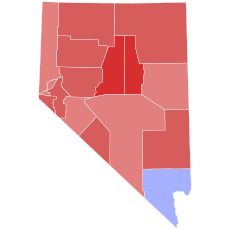 County results Gibbons: 50–60% 60–70% 70–80% Titus: 40–50% | |||||||||||||||||
| |||||||||||||||||
Governor Kenny Guinn, a moderate Republican, was term-limited. His retirement resulted in competitive primaries in both parties. The Democratic nominee was State Senate Minority Leader Dina Titus, who won the primary with 54% of the vote over Henderson mayor Jim Gibson. The Republican nominee was Congressman Jim Gibbons, who won the primary with 48% of the vote, defeating state senator Bob Beers and Lieutenant Governor Lorraine Hunt. Gibbons, who then represented Nevada's 2nd congressional district, had a strong base in northern Nevada. Titus had a strong base in the Las Vegas Valley due to her legislative and education careers. An October 17 Rasmussen Reports poll put Gibbons ahead of Titus with a 51% to 43% lead.[54] Polls in late October conducted by Mason-Dixon and Research 2000 indicated that Gibbons was on track to win the election.
Republican nominee Jim Gibbons was elected with 48% of the vote, a plurality. Titus received 44% of the vote and Christopher H. Hansen, the nominee of the Independent American Party of Nevada, received about 3%.
| Party | Candidate | Votes | % | |
|---|---|---|---|---|
| Republican | Jim Gibbons | 279,003 | 47.93 | |
| Democratic | Dina Titus | 255,684 | 43.92 | |
| None of These Candidates | 20,699 | 3.56 | ||
| Independent American | Christopher H. Hansen | 20,019 | 3.44 | |
| Green | Craig Bergland | 6,753 | 1.16 | |
| Total votes | 582,158 | 100.00 | ||
| Republican hold | ||||
New Hampshire
 | |||||||||||||||||
| |||||||||||||||||
| |||||||||||||||||
Lynch: 50–60% 60–70% 70–80% 80–90% >90% Coburn: 50–60% | |||||||||||||||||
| |||||||||||||||||
Incumbent Democrat John Lynch defeated Republican James B. Coburn and won a second term as Governor of New Hampshire.

| Party | Candidate | Votes | % | |
|---|---|---|---|---|
| Democratic | John Lynch | 298,760 | 74.01 | |
| Republican | Jim Coburn | 104,288 | 25.83 | |
| Write-in | 631 | 0.16 | ||
| Total votes | 403,679 | 100.00 | ||
| Democratic hold | ||||
New Mexico
 | ||||||||||||||||||||
| ||||||||||||||||||||
| ||||||||||||||||||||
 County results Richardson: 50–60% 60–70% 70–80% 80–90% Dendahl: 50–60% | ||||||||||||||||||||
| ||||||||||||||||||||
Incumbent Democratic Governor Bill Richardson was running for re-election. He faced Republican John Dendahl in the general election and won by a landslide.
| Party | Candidate | Votes | % | |
|---|---|---|---|---|
| Democratic | Bill Richardson (incumbent) | 384,806 | 68.82 | |
| Republican | John Dendahl | 174,364 | 31.18 | |
| Total votes | 559,170 | 100.00 | ||
| Democratic hold | ||||
New York
 | |||||||||||||||||||||||
| |||||||||||||||||||||||
| Turnout | 34.9% [58] | ||||||||||||||||||||||
|---|---|---|---|---|---|---|---|---|---|---|---|---|---|---|---|---|---|---|---|---|---|---|---|
| |||||||||||||||||||||||
 County results Spitzer: 40–50% 50–60% 60–70% 70–80% 80–90% Faso: 40–50% 50–60% | |||||||||||||||||||||||
| |||||||||||||||||||||||
Governor George Pataki, a moderate Republican, opted not to seek a fourth term in office. Without an incumbent in the race, the Democratic nominee was heavily favored to win the election. New York Attorney General Eliot Spitzer won the Democratic primary with 81% of the vote, defeating Nassau County Executive Tom Suozzi. As attorney general, Spitzer became well known for prosecuting cases relating to corporate white-collar crime, securities fraud, internet fraud and environmental protection. The Republican nominee was attorney John Faso, a former New York State Assembly minority leader. Throughout the race, polls showed Spitzer defeating Faso by a large margin.
Democratic nominee Eliot Spitzer was elected in a landslide, winning 58 out of the state's 62 counties and taking 65.3% of the vote.
| Gubernatorial election in New York, 2006 [59] | ||||||
|---|---|---|---|---|---|---|
| Party | Candidate | Running mate | Votes | Percentage | Swing | |
| Democratic | Eliot Spitzer | 2,740,864 | 58.34% |  26.84% 26.84% | ||
| Independence | Eliot Spitzer | 190,661 | 4.06% |  10.22% 10.22% | ||
| Working Families | Eliot Spitzer | 155,184 | 3.30% |  1.32% 1.32% | ||
| Total | Eliot Spitzer | David Paterson | 3,086,709 | 65.70% |  32.20% 32.20% | |
| Republican | John Faso | 1,105,681 | 23.54% |  22.00% 22.00% | ||
| Conservative | John Faso | 168,654 | 3.59% |  0.27% 0.27% | ||
| Total | John Faso | C. Scott Vanderhoef | 1,274,335 | 27.12% |  22.28% 22.28% | |
| Green | Malachy McCourt | Brian Jones | 42,166 | 0.89% |  0.02% 0.02% | |
| Libertarian | John Clifton | Chris Edes | 14,736 | 0.31% |  0.20% 0.20% | |
| Rent Is Too Damn High | Jimmy McMillan | None | 13,355 | 0.28% | N/A | |
| Socialist Workers | Maura DeLuca | Ben O'Shaughnessy | 5,919 | 0.13% | N/A | |
| Blank, Void, Scattering | 116,622 | 5.55% | ||||
| Majority | 1,812,374 | 38.58% |  22.68% 22.68% | |||
| Totals | 4,437,220 | 100.00% | ||||
| Democratic gain from Republican | Swing | |||||
Ohio
 | ||||||||||||||||||||
| ||||||||||||||||||||
| ||||||||||||||||||||
Strickland: 40–50% 50–60% 60–70% 70–80% 80–90% Blackwell: 40–50% 50–60% 60–70% | ||||||||||||||||||||
| ||||||||||||||||||||
Term-limited incumbent Governor Bob Taft was viewed as one of the most unpopular Governors in the history of Ohio. Polls showed his approval rating in the vicinity of 10% to 25%.
Congressman Ted Strickland won the Democratic primary with 79% of the vote, defeating state representative Bryan Flannery. The Republican primary, between Ohio Secretary of State Ken Blackwell and Ohio Attorney General Jim Petro, was more competitive by far. Petro came under fire for switching positions on same-sex marriage and abortion, as well as allegedly taking business from lawyers who refused to give him campaign contributions.[60] Blackwell and Petro also split over proposals to reduce state spending. Blackwell ultimately won the primary with 56% of the vote.
Blackwell was not a close ally of disgraced Governor Taft, but Taft's unpopularity still damaged his campaign. The negativity of the Republican primary also damaged Blackwell's general election campaign. In addition, in 2006 there was a nationwide trend towards the Democratic Party. An October 6 poll by Rasmussen Reports showed that Strickland led by 52% to 40%, a decline from September.[61] By contrast, an October 12 SurveyUSA poll had Strickland leading Blackwell 60% to 32%.[62]
Democratic nominee Ted Strickland was elected with 60.5% of the vote. He became the first Democratic Governor of Ohio since Dick Celeste.
| Party | Candidate | Votes | % | |
|---|---|---|---|---|
| Democratic | Ted Strickland | 2,435,384 | 60.54 | |
| Republican | Ken Blackwell | 1,474,285 | 36.65 | |
| Libertarian | Bill Peirce | 71,468 | 1.78 | |
| Green | Bob Fitrakis | 40,965 | 1.02 | |
| Write-in | 652 | 0.02 | ||
| Total votes | 4,022,754 | 100.00 | ||
| Democratic gain from Republican | ||||
Oklahoma
 | |||||||||||||||||
| |||||||||||||||||
| |||||||||||||||||
 County results Henry: 50–60% 60–70% 70–80% 80–90% Istook: 50–60% 60–70% | |||||||||||||||||
| |||||||||||||||||
Incumbent Democratic Governor Brad Henry won re-election to a second term in a landslide, defeating Republican U.S. Representative Ernest Istook. Henry took 66.5% of the vote to Istook's 33.5% and swept all but three counties in the state.[64]
| Party | Candidate | Votes | % | |
|---|---|---|---|---|
| Democratic | Brad Henry (incumbent) | 616,135 | 66.50 | |
| Republican | Ernest Istook | 310,327 | 33.50 | |
| Total votes | 926,462 | 100.00 | ||
| Democratic hold | ||||
Oregon
 | |||||||||||||||||
| |||||||||||||||||
| |||||||||||||||||
 County results Kulongoski: 40–50% 50–60% 60–70% | |||||||||||||||||
| |||||||||||||||||
Democratic Governor Ted Kulongoski was elected in 2002 barely defeating former State Representative Kevin Mannix. Kulongoski leads his challenger, former Portland Public School Board member Ron Saxton 51% to 44%.[66] Oregon has not elected a Republican as governor since 1982, when Kulongoski lost to then-Governor Victor Atiyeh. Democratic incumbent Ted Kulongoski was re-elected.
| Party | Candidate | Votes | % | |
|---|---|---|---|---|
| Democratic | Ted Kulongoski (incumbent) | 699,786 | 50.73 | |
| Republican | Ron Saxton | 589,748 | 42.75 | |
| Constitution | Mary Starrett | 50,229 | 3.64 | |
| Pacific Green | Joe Keating | 20,030 | 1.45 | |
| Libertarian | Richard Morley | 16,798 | 1.22 | |
| Write-in | 2,884 | 0.21 | ||
| Total votes | 1,379,475 | 100.00 | ||
| Democratic hold | ||||
Pennsylvania
 | ||||||||||||||||||||
| ||||||||||||||||||||
| ||||||||||||||||||||
Swann: 50–60% 60–70% 70–80% 80–90% >90% Rendell: 50–60% 60–70% 70–80% 80–90% >90% Tie: 50% No data | ||||||||||||||||||||
| ||||||||||||||||||||
Incumbent Democratic Governor Ed Rendell successfully ran for re-election. Pennsylvania's first female lieutenant governor, Catherine Baker Knoll, was also running for re-election.
| Party | Candidate | Votes | % | |
|---|---|---|---|---|
| Democratic | Ed Rendell (incumbent) | 2,470,517 | 60.33 | |
| Republican | Lynn Swann | 1,622,135 | 39.61 | |
| Write-in | 2,670 | 0.06 | ||
| Total votes | 4,095,322 | 100.00 | ||
| Democratic hold | ||||
Rhode Island
 | |||||||||||||||||
| |||||||||||||||||
| |||||||||||||||||
Carcieri: 50–60% 60–70% 70–80% Fogarty: 50–60% 60–70% 70–80% | |||||||||||||||||
| |||||||||||||||||
Polling in the race showed Donald Carcieri, Republican governor in one of the most liberal states in the country, running even with his Democratic challenger, Lieutenant Governor Charles J. Fogarty.[69] Carcieri was re-elected with 51% of the vote.
| Party | Candidate | Votes | % | |
|---|---|---|---|---|
| Republican | Donald Carcieri (incumbent) | 197,306 | 51.01 | |
| Democratic | Charles J. Fogarty | 189,503 | 48.99 | |
| Total votes | 386,809 | 100.00 | ||
| Republican hold | ||||
South Carolina
 | |||||||||||||||||
| |||||||||||||||||
| |||||||||||||||||
 County results Sanford: 50–60% 60–70% Moore: 50–60% 60–70% 70–80% | |||||||||||||||||
| |||||||||||||||||
Incumbent Republican Governor Mark Sanford won re-election against Democratic State Senator Tommy Moore, becoming only the third Republican governor in South Carolina to win a second term (Robert Kingston Scott and Carroll A. Campbell Jr. were the others). Sanford started the campaign with a double-digit edge over Moore and he maintained that lead to election day. During the course of the campaign, Sanford's approval rating averaged in the mid-fifties.[71] In Sanford's re-election victory, he also garnered 22% of the African American vote.
| Party | Candidate | Votes | % | |
|---|---|---|---|---|
| Republican | Mark Sanford (incumbent) | 601,868 | 55.12 | |
| Democratic | Tommy Moore | 489,076 | 44.79 | |
| Write-in | 1,008 | 0.09 | ||
| Total votes | 1,091,952 | 100.00 | ||
| Republican hold | ||||
South Dakota
 | ||||||||||||||||||||
| ||||||||||||||||||||
| ||||||||||||||||||||
 County results Rounds: 50–60% 60–70% 70-80% 80–90% | ||||||||||||||||||||
| ||||||||||||||||||||
Incumbent Republican Governor Mike Rounds defeated Democrat Jack Billion to serve a second term as governor.
| Party | Candidate | Votes | % | |
|---|---|---|---|---|
| Republican | Mike Rounds (incumbent) | 206,990 | 61.69 | |
| Democratic | Jack Billion | 121,226 | 36.13 | |
| Constitution | Steven J. Willis | 4,010 | 1.20 | |
| Libertarian | Tom Gerber | 3,282 | 0.98 | |
| Total votes | 335,508 | 100.00 | ||
| Republican hold | ||||
Tennessee
 | |||||||||||||||||
| |||||||||||||||||
| Turnout | 49.97%  [73] 0.43 pp [73] 0.43 pp | ||||||||||||||||
|---|---|---|---|---|---|---|---|---|---|---|---|---|---|---|---|---|---|
| |||||||||||||||||
 County results Bredesen: 50–60% 60–70% 70–80% 80–90% | |||||||||||||||||
| |||||||||||||||||
Incumbent Democratic Governor Phil Bredesen defeated Republican State Senator Jim Bryson in a landslide with 68.6% of the vote, winning every county in the state.
Primary elections were held on August 3, 2006.
As of 2024, this was the last time a Democrat won a majority of counties in the state, the last time a Democrat won any statewide race in Tennessee, and the most recent statewide election in Tennessee in which 88 of the state's 95 counties, including Knox County and Hamilton County, went to the Democratic candidate. Only Davidson, Shelby, Haywood, Hardeman, Houston, Jackson, and Lake counties have voted for a Democratic candidate in a Presidential, Senate, or gubernatorial race since 2006, with Jackson and Lake only going Democratic once. Eight years later, Republican Governor Bill Haslam won every county in the state when he won re-election. This marked a sharp political shift in Tennessee.
| Party | Candidate | Votes | % | |
|---|---|---|---|---|
| Democratic | Phil Bredesen (incumbent) | 1,247,491 | 68.60 | |
| Republican | Jim Bryson | 540,853 | 29.74 | |
| Independent | Carl Two Feathers Whitaker | 11,374 | 0.63 | |
| Independent | George Banks | 7,531 | 0.41 | |
| Independent | Charles E. Smith | 4,083 | 0.22 | |
| Independent | Howard W. Switzer | 2,711 | 0.15 | |
| Independent | David Gatchell | 2,385 | 0.13 | |
| Independent | Marivuana Stout Leinoff | 2,114 | 0.12 | |
| Write-in | 7 | 0.00 | ||
| Total votes | 1,818,549 | 100.00 | ||
| Democratic hold | ||||
Texas
 | |||||||||||||||||||||||||||||||||||||
| |||||||||||||||||||||||||||||||||||||
| |||||||||||||||||||||||||||||||||||||
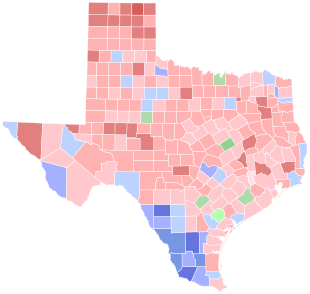 County results Perry: 20–30% 30–40% 40–50% 50–60% 60–70% | |||||||||||||||||||||||||||||||||||||
| |||||||||||||||||||||||||||||||||||||
Challenges from two popular independents, coupled with Perry's mediocre approval ratings, made the race interesting. Populist state Comptroller Carole Keeton Strayhorn decided to defect from the GOP and run against Perry, her bitter political foe, as an independent. Six weeks after the announcement of her candidacy, she moved to within single digits of Perry in polls. In addition to Perry and Strayhorn, former Congressman Chris Bell ran as the Democratic candidate, with country singer and Texas icon Kinky Friedman as another independent. This resulted in a peculiar four-way race (technically, a six-way race including the Libertarian candidate and a write-in candidate) in which no run-off would take place. Perry was elected to a second full term with just 39% of the vote.
| Party | Candidate | Votes | % | |
|---|---|---|---|---|
| Republican | Rick Perry (incumbent) | 1,716,803 | 39.03 | |
| Democratic | Chris Bell | 1,310,353 | 29.79 | |
| Independent | Carole Keeton Strayhorn | 797,577 | 18.13 | |
| Independent | Kinky Friedman | 546,869 | 12.43 | |
| Libertarian | James Werner | 26,748 | 0.61 | |
| Write-in | 718 | 0.02 | ||
| Total votes | 4,399,068 | 100.00 | ||
| Republican hold | ||||
Vermont
 | |||||||||||||||||
| |||||||||||||||||
| |||||||||||||||||
Douglas: 40–50% 50–60% 60–70% 70–80% 80–90% Parker: 40–50% 50–60% 60–70% 70–80% | |||||||||||||||||
| |||||||||||||||||
Incumbent Republican Governor Jim Douglas won re-election to a third term, defeating Democratic nominee Scudder Parker.
| Party | Candidate | Votes | % | |
|---|---|---|---|---|
| Republican | Jim Douglas (incumbent) | 148,014 | 56.38 | |
| Democratic | Scudder Parker | 108,090 | 41.17 | |
| Independent | Cris Ericson | 2,477 | 0.94 | |
| Green | Jim Hogue | 1,936 | 0.74 | |
| Independent | Benjamin Clarke | 1,216 | 0.46 | |
| Liberty Union | Robert Skold | 638 | 0.24 | |
| Write-in | 153 | 0.06 | ||
| Total votes | 262,524 | 100.00 | ||
| Republican hold | ||||
Wisconsin
 | |||||||||||||||||
| |||||||||||||||||
| |||||||||||||||||
Doyle: 30–40% 40–50% 50–60% 60–70% 70–80% 80–90% >90% Green: 40–50% 50–60% 60–70% 70–80% 80–90% >90% Tie: 40–50% 50% No data | |||||||||||||||||
| |||||||||||||||||
In 2002, Doyle was elected with only 45 percent of the vote because of an unusually strong challenge from the Libertarian party. Although his early 2006 approval rating was a mildly unfavorable 45 percent, he led both Republican challengers, Milwaukee County Executive Scott Walker and Congressman Mark Green by six to nine points in polls; he has not been able to poll greater than fifty percent. Green got a big break when Walker dropped out of the race. And more recent polls show that Green has pulled even. Wisconsin is a swing state in the strongest sense, with George W. Bush losing the state by some 5,700 votes in 2000 and around 12,400 votes in 2004, although they hadn't voted for a Republican for president since 1984, and they hadn't had a Republican senator since 1993. An October 18 Rasmussen Reports poll has Doyle leading Green 48% to 44%[77] and an October 31 Research 2000 poll has Doyle leading Green 50% to 44%.[78] Democratic incumbent Jim Doyle was re-elected.
| Party | Candidate | Votes | % | |
|---|---|---|---|---|
| Democratic | Jim Doyle (incumbent) | 1,139,115 | 52.76 | |
| Republican | Mark A. Green | 979,427 | 45.36 | |
| Green | Nelson Eisman | 40,709 | 1.89 | |
| Total votes | 2,159,251 | 100.00 | ||
| Democratic hold | ||||
Wyoming
 | |||||||||||||||||
| |||||||||||||||||
| |||||||||||||||||
 County results Freudenthal: 50–60% 60–70% 70–80% 80–90% | |||||||||||||||||
| |||||||||||||||||
Incumbent Democratic Governor Dave Freudenthal won re-election in a landslide over Republican Ray Hunkins, becoming the first Democrat since 1910 to win every county in the state. To date this was the last time a Democrat was elected to statewide office in Wyoming, the last time a Democrat carried every county in the state, the last gubernatorial election in which a Democrat received more than 30% of the vote, and the last statewide election in which a Democrat received more than 45% of the vote.
| Party | Candidate | Votes | % | |
|---|---|---|---|---|
| Democratic | Dave Freudenthal (incumbent) | 135,516 | 69.99 | |
| Republican | Ray Hunkins | 58,100 | 30.01 | |
| Total votes | 193,616 | 100.00 | ||
| Democratic hold | ||||
Territories and federal district
District of Columbia
 | |||||||||||||||||
| |||||||||||||||||
| |||||||||||||||||
 Results by ward: Fenty—>90% Fenty—80–90% | |||||||||||||||||
| |||||||||||||||||
The Democratic primary was held on September 12. The winner of that and general election was Adrian Fenty, the representative for Ward 4 on the D.C. Council. He took office on January 2, 2007, becoming the sixth directly elected mayor since the establishment of home rule in the District, and — at 35 — the youngest elected mayor of a major American city in U.S. history.
| Party | Candidate | Votes | % | |
|---|---|---|---|---|
| Democratic | Adrian Fenty | 98,740 | 89.73 | |
| Republican | David Kranich | 6,744 | 6.13 | |
| DC Statehood Green | Chris Otten | 4,554 | 4.14 | |
| Total votes | 110,038 | 100.00 | ||
| Democratic hold | ||||
Guam
 | ||||||||||||||||||||
| ||||||||||||||||||||
| ||||||||||||||||||||
| ||||||||||||||||||||
In the U.S. territory of Guam, in the western Pacific Ocean, Republican Governor Felix P. Camacho was challenged by Democrat Robert Underwood. A former Guam Delegate-at-Large in the U.S. House of Representatives, Underwood had previously represented Guam from 1993 to 2003. The race was a rematch of the 2002 gubernatorial election in which Camacho handily defeated Underwood and won his first term in office by 10 points (see Politics of Guam). However, the race was significantly more close and competitive in 2006, with Camacho narrowly winning re-election by a 2-point margin over Underwood.
| Party | Candidate | Votes | % | |
|---|---|---|---|---|
| Republican | Felix Perez Camacho (incumbent) | 19,560 | 50.25 | |
| Democratic | Robert A. Underwood | 18,700 | 48.04 | |
| Write-in | 668 | 1.72 | ||
| Total votes | 38,928 | 100.00 | ||
| Republican hold | ||||
U.S. Virgin Islands
 | ||||||||||||||||||||
| ||||||||||||||||||||
| Turnout | 29,046 | |||||||||||||||||||
|---|---|---|---|---|---|---|---|---|---|---|---|---|---|---|---|---|---|---|---|---|
| ||||||||||||||||||||
| ||||||||||||||||||||
| Party | Candidate | Votes | % | |
|---|---|---|---|---|
| Democratic | John de Jongh Jr. | 16,644 | 57.30 | |
| Independent | Kenneth Mapp | 12,402 | 42.70 | |
| Total votes | 29,046 | 100.00 | ||
| Democratic hold | ||||
See also
Notes
References
External links
- Major Problems At Polls Feared, Dan Balz and Zachary A. Goldfarb, The Washington Post, September 17, 2006






